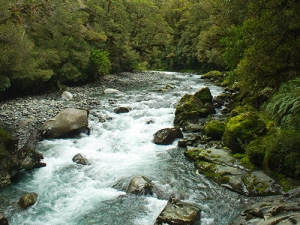Taranaki economy shifts from oil and gas to dairy as leading export
The Taranaki region is enjoying one of the highest gross domestic product (GDP) per capita figures in New Zealand, thanks to high farmgate dairy prices.
 There are no ecological monitoring sites in Taranaki showing significant negative trends. Image: Paul Nelhams.
There are no ecological monitoring sites in Taranaki showing significant negative trends. Image: Paul Nelhams.
Taranaki's latest freshwater report shows ecological health for the region's waterways are showing some of the best results ever in the past 19 years.
Ecological water health is largely determined by macroinvertebrate monitoring, the number of tiny insects and species found in streams. Taranaki's 2014-15 results of macroinvertebrate (MCI) monitoring show some Taranaki sites have the best ever results since records began in 1995. These latest results were released in March 2016.
MCI is a nationally recognised measure of water health, used by many regions, which TRC scientists helped develop in the 1980s. MCI assigns a score to each species (from 1 -10), based on its tolerance or sensitivity to organic pollution, then calculates the average score of all species present at a site to rate the water quality.
Currently more than half of monitoring sites (29 out of 57) are in the two positive categories for water health – 22 have a positive and very significant MCI trend, up from 15 just three years ago, and a further seven sites have a significant positive trend.
There are no ecological monitoring sites in Taranaki showing significant negative trends.
There are also more than four times as many sites showing strong, significant improvement compared to seven years ago.
Taranaki streams and rivers showing the strongest evidence of MCI statistical and ecological improvement in water quality are:
· Kaupokonui Stream upstream of the Fonterra Kapuni factory
· Mangaehu River at Raupuha Rd
· Punehu Stream at SH45
· Kapoaiaia Stream at Wiremu Rd
· Mangawhero Stream upstream of Waingongoro River confluence
· Kaupokonui Stream upstream of STDC Kaponga WWTP
· Kapoaiaia Stream at Wataroa Rd
· Mangati Stream at Bell Block.
The full technical report, titled Freshwater Macroinvertebrate Fauna Biological Monitoring Programme 2014-2015 can be seen here: http://www.trc.govt.nz/assets/Publications/state-of-the-environment-monitoring/environmental-monitoring-technical-reports/1603850w.pdf
The findings were presented to the council's policy and planning committee on March 17, 2016.
Acclaimed fruit grower Dean Astill never imagined he would have achieved so much in the years since being named the first Young Horticulturist of the Year, 20 years ago.
The Ashburton-based Carrfields Group continues to show commitment to future growth and in the agricultural sector with its latest investment, the recently acquired 'Spring Farm' adjacent to State Highway 1, Winslow, just south of Ashburton.
New Zealand First leader and Foreign Affairs Minister Winston Peters has blasted Fonterra farmers shareholders for approving the sale of iconic brands to a French company.
A major feature of the Ashburton A&P Show, to be held on October 31 and November 1, will be the annual trans-Tasman Sheep Dog Trial test match, with the best heading dogs from both sides of the Tasman going head-to-head in two teams of four.
Fewer bobby calves are heading to the works this season, as more dairy farmers recognise the value of rearing calves for beef.
The key to a dairy system that generates high profit with a low emissions intensity is using low footprint feed, says Fonterra program manager on-farm excellence, Louise Cook.